Posted: September 2nd, 2010 | Author: Halbe | Filed under: Uncategorized | 7 Comments »
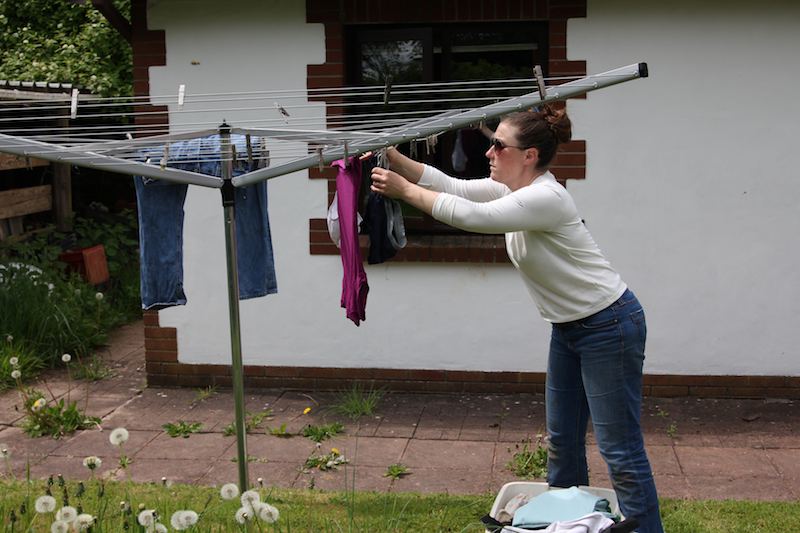
A consistent change Devon and I have had to make on this trip involves our laundry – we don’t use dryers, we use clotheslines.
When we first used one in England we thought it was a bit of an anomaly. We didn’t mind using it, but thought it was kind of a pain in the butt to coordinate our laundry with weather. Then we went to Wales. They too had a clothesline. In fact, every place we’ve visited has had a clothesline. Many don’t even have dryers.
So, what’s up with the states? Why don’t we use clotheslines? I know we used to, so where have all the clothes lines gone? I grew up with a dryer my whole life. You only had a clothesline if you didn’t have the money to buy a dryer. The U.S.’s attitude of quick, easy and unconcerned with environmental impact, I think, is well illustrated with the disappearance of the clothesline.
Recently, for obvious reasons, there’s a lot of talk of energy conservation, alternative energy etc. I think using a clothesline is one of the easiest and quickest ways to make a clear and significant impact. If you live in an area that has sun any time of year, I say use a clothesline.
# 10 on our list of things to have when we go back: clothesline.
Posted: September 1st, 2010 | Author: Halbe | Filed under: Uncategorized | No Comments »
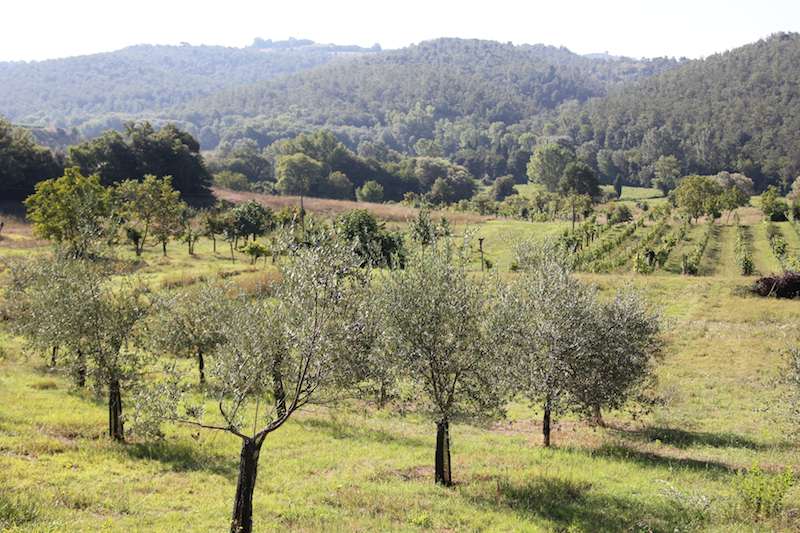
At our last place in Tuscany, we were helping on a smallholding (property with a farm under 50 acres) that had a small vineyard and olive grove. Devon and I worked in the olive grove for a bit and learned a lot about olive trees. The most interesting part was the trimming.
An olive tree would virtually be a bush if it weren’t for a whole lot of pruning and shaping. An olive tree will just grow branches anywhere it can. In fact, if a tree has been frozen due to cold weather, or had appeared to be “dead,” the solution is to cut the tree down to a stump. New branches will grow out of the stump, and voila, the olive tree is back.
Part of the pruning process was to open up the center. Each olive tree should have a dome like center with little to no branches in the middle. To create and maintain this shape, Devon and I were charged with cutting out all the suckers and any branches that were growing straight into the center.
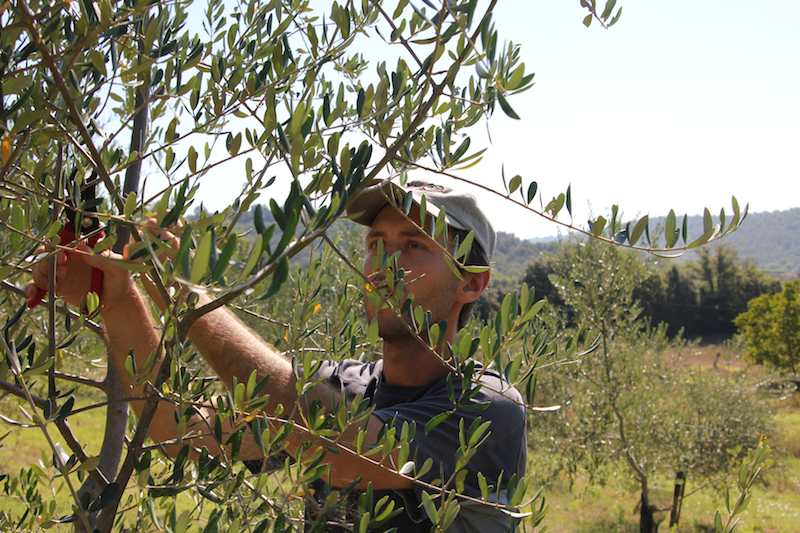
At first, we weren’t sure how to tell if the branch was a sucker. But, eventually, we got the hang of it. The suckers were usually new growth and the bark was lighter than the rest of the tree. Anything growing right into the center should be cut. A branch that looked like it could be coaxed to grow away from the center should be pulled out and guided to point down. In the end, you want a tree with branches primarily pointing down at the ground with a hollow-esque center.
Olive trees take a while to grow, but can also last forever. The trees we pruned were four years old and pretty small. They were just starting to produce olives. To make his olive oil, our host would harvest the olives by hand and then send them to the co-op which creates the oil for him. Financially, it made more sense to have the oil produced by the co-op.
We were able to enjoy his olives and olive oil. I loved both – they tasted so authentic and “fresh,” (which is a strange thing to say about something that’d been sitting in a jar for five years). Devon, however, thought the oil was lovely but the olives were too bitter. We hope to try more olive oil and olives while we’re out here to compare.
Posted: August 31st, 2010 | Author: Halbe | Filed under: Italy, Recipes, Tuscany | 3 Comments »
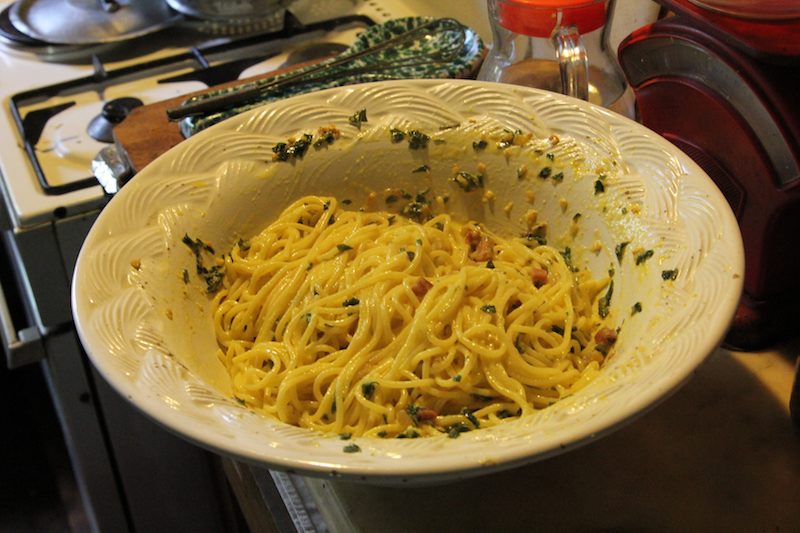
In Italy, I’ve been cooking a lot more than other places. The best part is that I’m actually learning how to cook better which was one of my goals for this trip. So, for Devon’s birthday I set out to cook him a scrumptious meal. He wasn’t in the mood for a pasta with tomato sauce because we’d had a lot of that. He wanted carbonara instead – a pasta with an egg sauce.
My dad makes a great carbonara pasta so I just tried to re-create that. The result is the above pasta. When Devon, our host Ugo, and I sat down to eat my creation Devon and I were pleased. But, our host had a small suggestion. “For me,” he said, “this pasta is overcooked. The Italian way is to make it more al dente.” I thought I’d done that, but according to our host it still wasn’t the Italian way. So I asked him how it was done “the Italian way.”
He told me, the trick is to take the pasta out of the water before you think it’s ready. When you cook pasta you normally taste is until you think it’s soft enough to plate. In Italy that’s too late. You should actually take it out while it’s still a little on the hard side, just a little harder than you’d want it in the meal. The reason for this? The pasta continues to cook in the hot water while you get your colander ready, it cooks in the colander while it’s draining and it cooks in the bowl while you’re mixing it with the sauce. By the time it hits the table, it’s perfect.
I took his notes and applied it to our pasta the next day (making another dish my dad cooks). When I asked Ugo if the pasta was cooked more appropriately this time, he said, “Oh, I didn’t even notice. That means it’s good!”
Success!
For foodies out there, here’s the recipe for the carbonara I cooked. Note, I did this without a recipe, so the portions are not set in stone. If you want more prosciutto, parsley or parmesan just add it. It won’t kill the dish. It’ll just make it better:
Serves 4-5
1/2 a package of spaghetti (one of the smaller boxes or bags)
2 tbsp EVO
4 raw eggs
1/2 cup – 1 cup finely grated parmesan (depending on your taste)
1 cup fresh Italian parsley (English parsley will do as well)
6-7 slices of prosciutto (it’s kind of to taste, so you can do more or less)
4 cloves of garlic
Instructions:
1. Put a large pot of salted water on to boil (obviously, add pasta when it comes to a boil)
2. While that’s heating, finely chop the prosciutto, garlic and parsley.
3. In a small to medium sized frying pan, saute the garlic over medium heat. Move it around a bit so it doesn’t burn.
4. After 2-3 minutes, add the parsley and prosciutto to the garlic and EVO and saute all together until the prosciutto is cooked.
5. Meanwhile, find a large serving bowl (what you’d like to serve the pasta in) and crack the 4 eggs into it.
6. Mix the parmesan in with the eggs and beat together.
7. Once the pasta is almost ready to be strained add the prosciutto to the egg mixture.
8. Strain the pasta and without washing it add the hot pasta to the egg mixture. Mix all together fully. As the hot pasta mixes with the egg, it’ll cook the egg onto each strand of pasta. Timing is of the essence so don’t let the pasta cool and especially don’t wash it with cool water.
9. Serve with a green salad and crusty bread, if you’re so inclined.
P.S. Message to dad – you’ll probably go and look in your recipe book for this dish now and see my portions are a bit off, but it’s the best I could do while in Italy without your cook book and guidance 😉
Posted: August 30th, 2010 | Author: Halbe | Filed under: Italy, Tuscany, Umbria, Wine | 1 Comment »
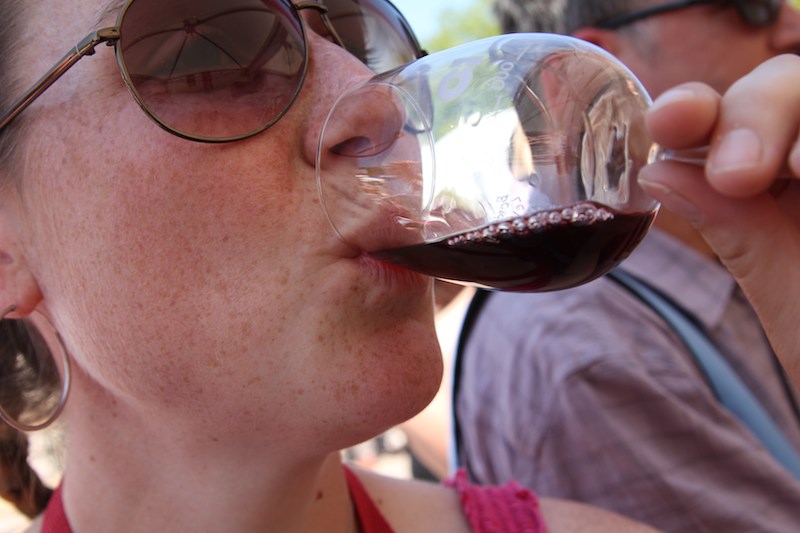
Red wine was never favorite of mine. It was usually overly strong, heavy and sometimes too “in your face.” Being in Europe though, I have grown an appreciation for red wine and now enjoy it quite a lot. In fact, I’d even say, in some situations, I prefer red wine.
The reds we tasted in France were wonderful, especially from the Bordeaux and Bergundy area. What’s finally pushed me to the other side, though, are the reds in Tuscany and Umbria. We’ve had multiple reds that really impressed us. In Tuscany, we bought a bottle of Rosso di Montepulciano, which uses two grapes I wasn’t familiar with: sangiovese 90% (the primary grape used in Tuscany) and canaiolo nero 10% (which has a distinct violet flavor). It’s probably my favorite red I’ve had on this trip so far.
The wine is also incredibly cheap. It was reasonable in France for American standards, but in Italy, it’s dirt cheap. Devon and I went to a wine bar and I was served a Tuscan red which cost 2.50 euros (around $3). Those are serious happy hour prices and it was 9:00 p.m.! I’m going back to the states with a much greater appreciation for red wine. You won’t hear me say “I prefer white,” anymore. Because in Italy and France, I’m a red girl.
Posted: August 29th, 2010 | Author: Devon | Filed under: Italy, Umbria | 3 Comments »
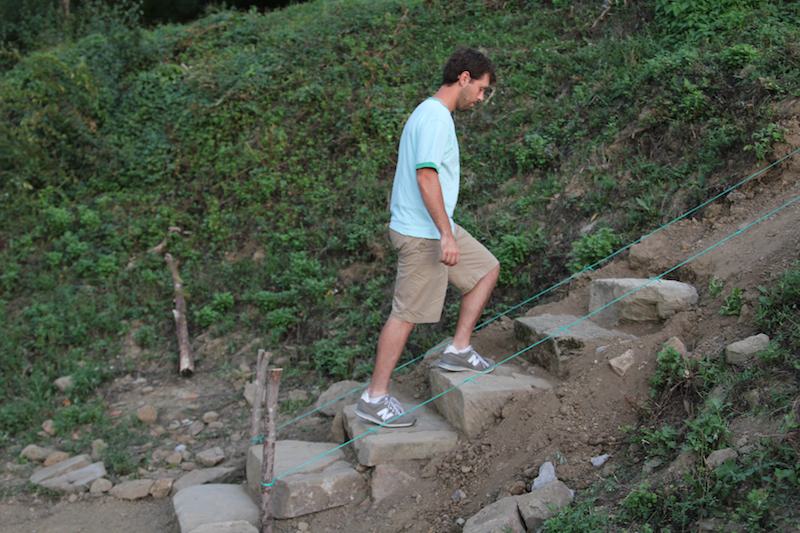
Remember that pickaxe work I was doing a few days ago? That rough hillside of weeds and rocks has slowly succumb to the unstoppable march of progress Where once there was nothing, there are now six stone steps, and I am pleased-as-punch with them. I had no idea what I was doing, but that certainly didn’t stop me from digging up my host’s property.
I began by sinking those four stakes, then tying two long green cords in parallel, marking the outer borders of the stairs. I used a level to ensure they were at the appropriate height and distance all the way down. Then, with the pickaxe, I tore the ground up between those strings, removing larger rocks, weeds, etc., and attempted to get the earth into a smooth slope that approximated the slope of the strings. Then I measured out the depth of a step (46.8 cm), then tied little knots on the strings to demarcate those distances for each step. That was one day.
Then I spent a day trying to dig post holes from the handrails. It didn’t work out. I don’t want to talk about it.
Then today, with the assistance of fellow helper Jonathan, we began dragging those big, heavy stones into place, and arranging them to look like a staircase. Each stone weighs in the 150-400 pound range. At first we rolled them end over end, but after the third step (which was a huge pain), we began sliding them down from above. It took about an hour for each step: finding the rock, moving the rock, then carefully placing the rock and packing smaller rocks and dirt around it so it doesn’t wobble.
Unfortunately, I’m leaving here tomorrow, so I will not able to see this project through to completion. I’m bummed, but happy with what we’ve done so far. It’s so satisfying to spend a day working, then to be able to see and use the thing you spent your time on.
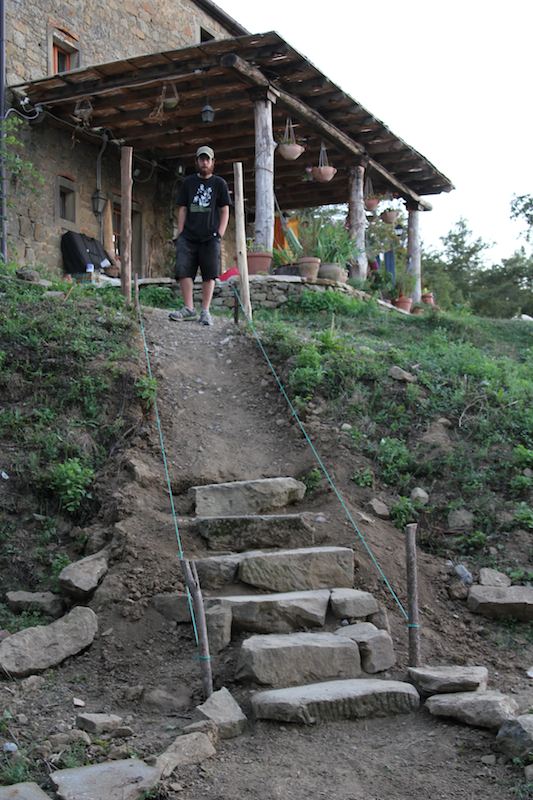
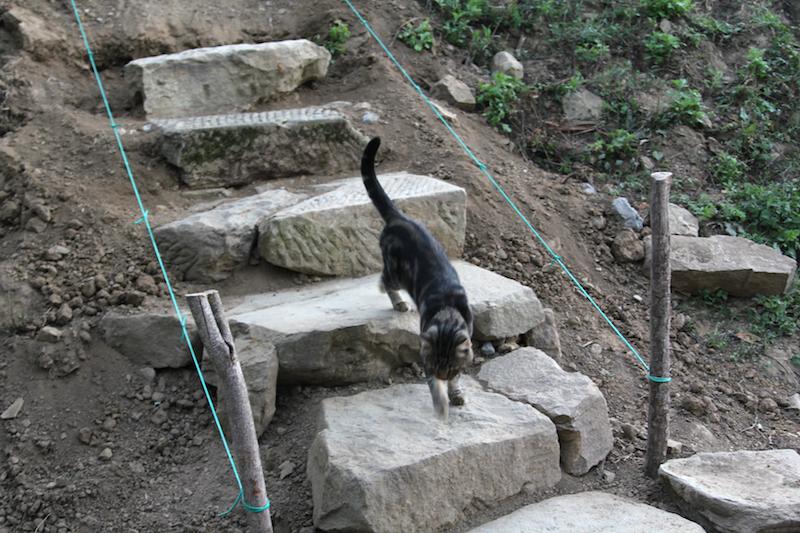
Posted: August 28th, 2010 | Author: Halbe | Filed under: Los Angeles | 5 Comments »
After going through seven helpx hosts and four countries, Devon and I have been compiling a list of things we want to have in our lives when we get back to the states. Some of these are long term ideas, and some can happen immediately. Below is the list, which is constantly being added to:
1. Ducks – they’re much more rad than chickens and their eggs are just as delicious, and larger.
2. Hammock – we’ve read many a book and have been swung asleep in the hammocks in Umbria. Apparently the best are from Guatemala.
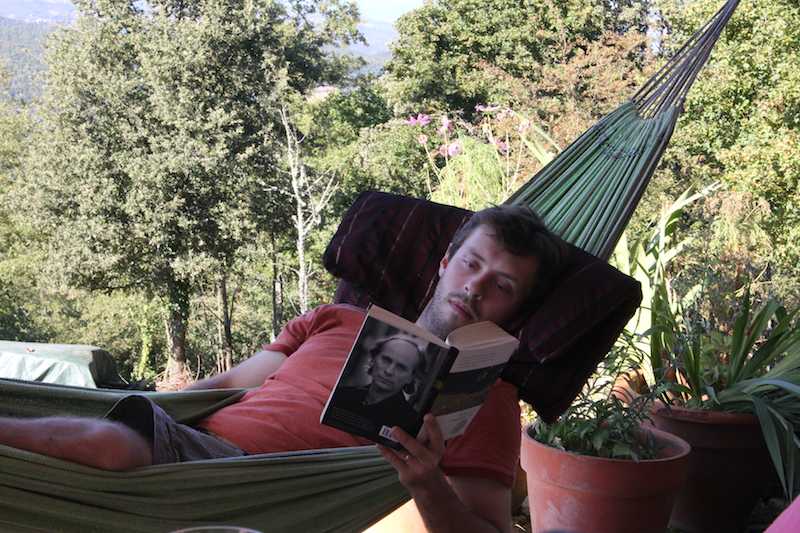
3. Large patio/deck – we want an outdoor living area with sofas, chairs and tables. Meals are wonderful on them and it creates an atmosphere that we both really enjoy.
4. Herb and salad garden – there’s nothing better than sprucing up cooking with fresh herbs and making salad with lettuce picked that afternoon.
5. Dog – we both grew up with dogs and we really miss having them around. Most hosts have had them and it’s reminded us how much we love living with dogs.
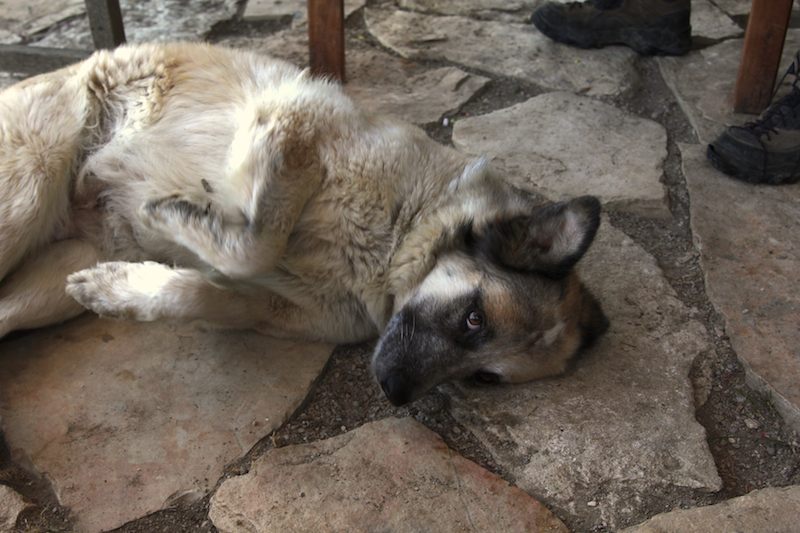
This was our favorite dog on the whole trip, Carina. She was our companian on most hikes in Umbria.
6. Roses – I tended roses in Normandy. I found working with them to be relaxing, and the reward large – they’re just so gorgeous.
7. Cast iron wok – I’ve done a lot of cooking on the trip and the wok has been a staple with most meals. I even fry pasta in it.
8. System for reclaiming water – our hosts in Devon County reclaimed a lot of their rain water to feed their animals. It was inspiring and very doable.
9. Meet more people – we’ve met more wonderful strangers than we ever anticipated. It’s easy to stick with people you know and not reach out, but when we get back, we’d like to change that.
Posted: August 27th, 2010 | Author: Halbe | Filed under: Italy, Tuscany | 2 Comments »
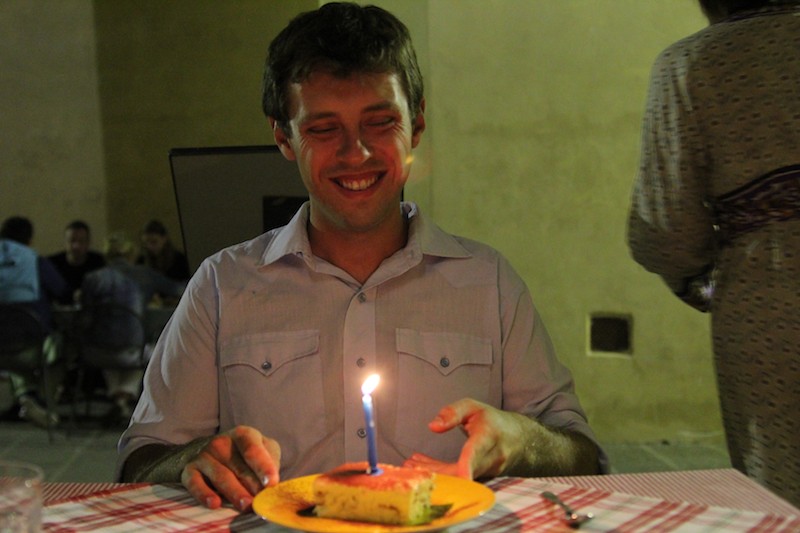
Devon’s 29th birthday was on August 18th and we spent it at a little restaurant in a nearby hill town of Tuscany called Castelmuzio. We had a delicious meal. It started with bruschetta mista (mixed bruschetta) as an antipasta that had toppings of eggplant, sausage, peppers and tomatoes. As an entree, Devon had gnocchi with mushroom sauce and I had stuffed eggplant. This was all washed down with a bottle of water (they don’t serve tap here) and 1/2 a liter of house red wine.
For dessert, which we obviously couldn’t skip, Devon had his favorite Italian sweet, tiramisu, and I had a chocolate pudding with mascarpone sauce. The tiramisu was by far one of the best I’ve had and Devon said it’s the best he’s ever had. The tiramisu was served with a candela and all the waitresses passed with birthday wishes, “Auguri!”
Posted: August 26th, 2010 | Author: Devon | Filed under: Italy, Umbria | 4 Comments »
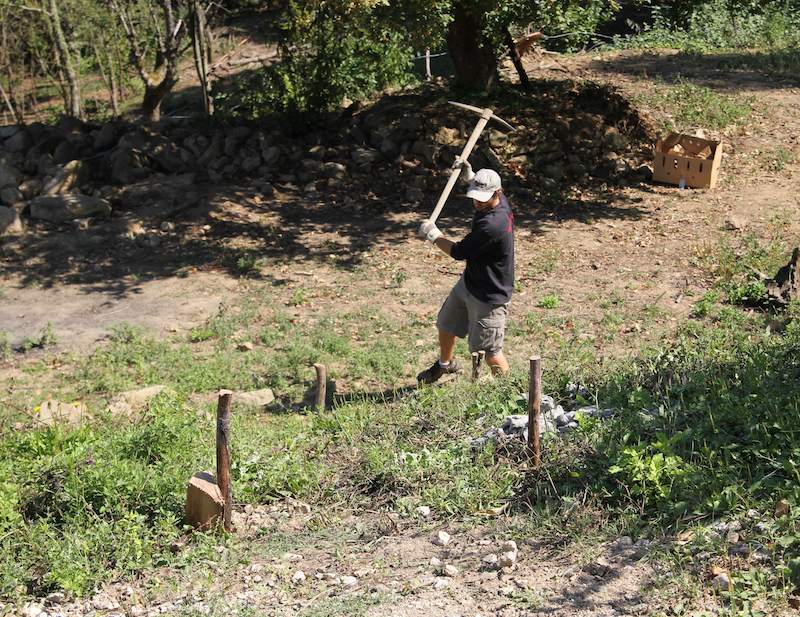
Some have commented that, according to this blog, we appear to rarely work. Update after update shows us lounging, sipping cool drinks under cabanas or something like that. So, in response, here is a photo of what I was doing this morning: smacking a pick axe into stone-chocked hillside. I’m helping build and install a stone staircase. I started by sinking those four vertical stakes, which now hold the guide lines that dictate the boundaries of the stairs.
Posted: August 25th, 2010 | Author: Devon | Filed under: Italy, Umbria | 1 Comment »
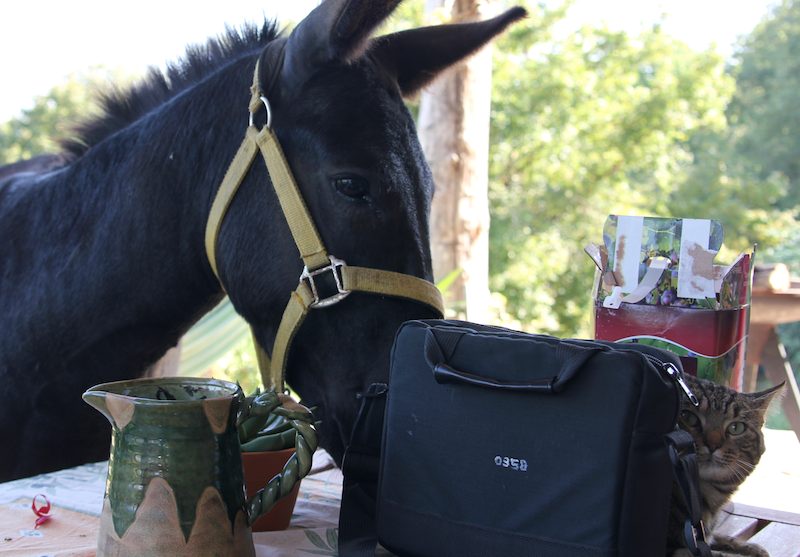
The family donkey wants to be friends with the sleeping, family cat, who does not. This was the scene at this mornings breakfast table. The donkey has been out of its pen, wandering onto the porch, trying to sneak sips of my tea, and of course, harassing the cat.
Posted: August 23rd, 2010 | Author: Devon | Filed under: Italy, Tuscany, Video | 6 Comments »
Under The Tuscan Rain from Devon DeLapp on Vimeo.
A rainy afternoon at Podere Trove, near Petroio (you can hear their church bells), in Tuscany Italy. Shot with the Canon Rebel T2i and cut in that great and deeply respected stalwart of editing, iMovie.












